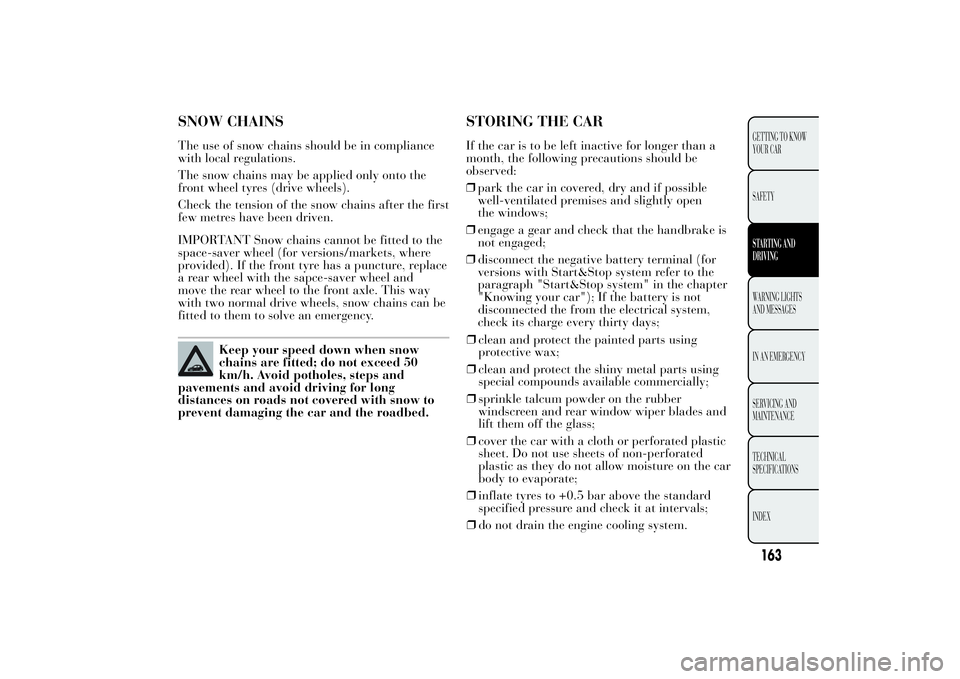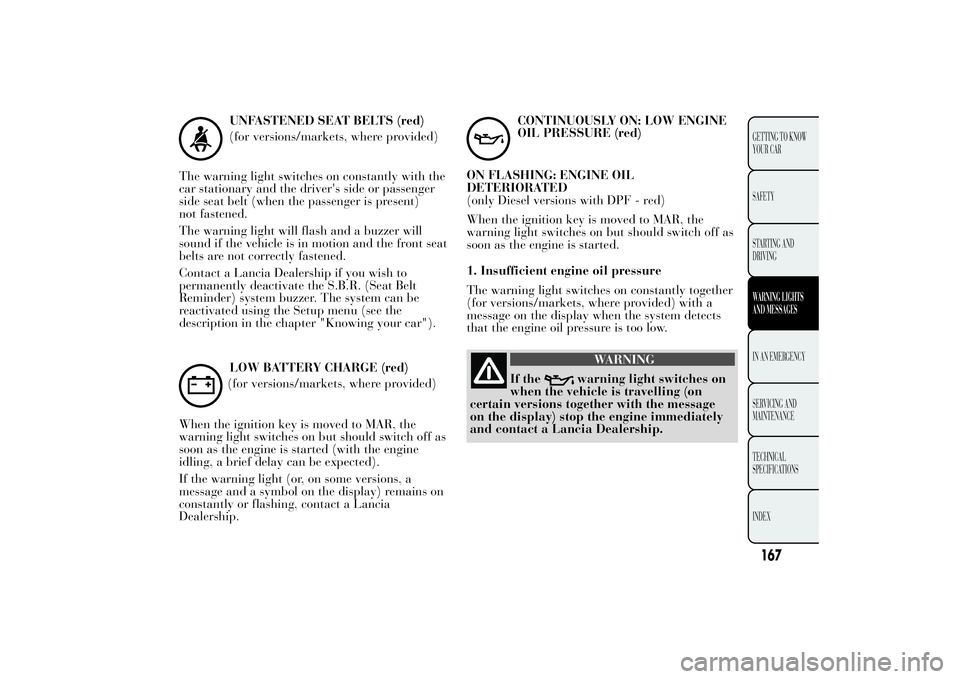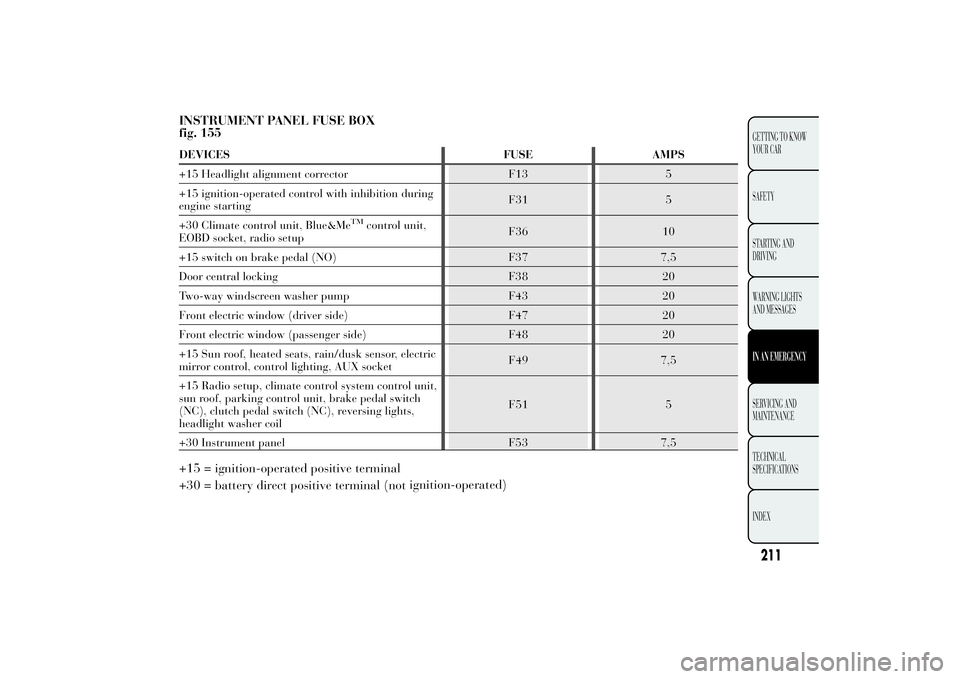battery Lancia Ypsilon 2014 Owner handbook (in English)
[x] Cancel search | Manufacturer: LANCIA, Model Year: 2014, Model line: Ypsilon, Model: Lancia Ypsilon 2014Pages: 315, PDF Size: 13.18 MB
Page 165 of 315

In addition to the electrical branches, the car's
electrical system can be connected only to the
supply cable for an electric brake and to the cable
for an internal trailer light, though not more
than 15 W. To connect, use the preset control unit
with a battery cable with cross-section no less
than 2.5 mm
2.
IMPORTANT The use of auxiliary loads other
than external lights (electric brake, winch, etc.)
must occur with engine running.
IMPORTANT To install a tow hook contact a
Lancia Dealership.
WARNING
The ABS with which the car may be
equipped will not control the braking
system of the trailer. Particular caution is
required on slippery roads.
WARNING
Never modify the braking system of
the car to control the trailer brake.
The trailer braking system must be fully
independent of the car’s hydraulic system.
161GETTING TO KNOW
YOUR CAR
SAFETYSTARTING AND
DRIVINGWARNING LIGHTS
AND MESSAGES
IN AN EMERGENCY
SERVICING AND
MAINTENANCE
TECHNICAL
SPECIFICATIONS
INDEX
TOWING TRAILERSIMPORTANT NOTES
For towing caravans or trailers the car must be
fitted with a type-approved tow hook and an
adequate electrical system. Installation must be
carried out by a specialist.
Install any specific and/or additional rear view
mirrors as specified by the Highway Code.
Remember that when towing a trailer, steep hills
are harder to climb, braking distances increase
and overtaking takes longer depending on the
overall weight of the trail.
Engage a low gear when driving downhill, rather
than constantly using the brake.
The weight of the trailer on the car's tow hook will
reduce the load capacity of the car by the same
amount. To make sure that the maximum towable
weight is not exceeded (given in the car
registration document) account should be taken of
the fully laden trailer, including accessories and
luggage.
Respect the speed limits specific to each country
for vehicles towing trailers. In any case, the top
speed must not exceed 100 km/h.
Any electric brake or other device (winch etc.)
should be powered directly by the battery through
a cable with a cross-section of no less than 2.5
mm
2.
Page 167 of 315

STORING THE CARIf the car is to be left inactive for longer than a
month, the following precautions should be
observed:
❒park the car in covered, dry and if possible
well-ventilated premises and slightly open
the windows;
❒engage a gear and check that the handbrake is
not engaged;
❒disconnect the negative battery terminal (for
versions with Start&Stop system refer to the
paragraph "Start&Stop system" in the chapter
"Knowing your car"); If the battery is not
disconnected the from the electrical system,
check its charge every thirty days;
❒clean and protect the painted parts using
protective wax;
❒clean and protect the shiny metal parts using
special compounds available commercially;
❒sprinkle talcum powder on the rubber
windscreen and rear window wiper blades and
lift them off the glass;
❒cover the car with a cloth or perforated plastic
sheet. Do not use sheets of non-perforated
plastic as they do not allow moisture on the car
body to evaporate;
❒inflate tyres to +0.5 bar above the standard
specified pressure and check it at intervals;
❒do not drain the engine cooling system.
163GETTING TO KNOW
YOUR CAR
SAFETYSTARTING AND
DRIVINGWARNING LIGHTS
AND MESSAGES
IN AN EMERGENCY
SERVICING AND
MAINTENANCE
TECHNICAL
SPECIFICATIONS
INDEX
SNOW CHAINSThe use of snow chains should be in compliance
with local regulations.
The snow chains may be applied only onto the
front wheel tyres (drive wheels).
Check the tension of the snow chains after the first
few metres have been driven.
IMPORTANT Snow chains cannot be fitted to the
space-saver wheel (for versions/markets, where
provided). If the front tyre has a puncture, replace
a rear wheel with the sapce-saver wheel and
move the rear wheel to the front axle. This way
with two normal drive wheels, snow chains can be
fitted to them to solve an emergency.
Keep your speed down when snow
chains are fitted; do not exceed 50
km/h. Avoid potholes, steps and
pavements and avoid driving for long
distances on roads not covered with snow to
prevent damaging the car and the roadbed.
Page 171 of 315

UNFASTENED SEAT BELTS (red)
(for versions/markets, where provided)
The warning light switches on constantly with the
car stationary and the driver's side or passenger
side seat belt (when the passenger is present)
not fastened.
The warning light will flash and a buzzer will
sound if the vehicle is in motion and the front seat
belts are not correctly fastened.
Contact a Lancia Dealership if you wish to
permanently deactivate the S.B.R. (Seat Belt
Reminder) system buzzer. The system can be
reactivated using the Setup menu (see the
description in the chapter "Knowing your car").LOW BATTERY CHARGE (red)
(for versions/markets, where provided)
When the ignition key is moved to MAR, the
warning light switches on but should switch off as
soon as the engine is started (with the engine
idling, a brief delay can be expected).
If the warning light (or, on some versions, a
message and a symbol on the display) remains on
constantly or flashing, contact a Lancia
Dealership.
CONTINUOUSLY ON: LOW ENGINE
OIL PRESSURE (red)
ON FLASHING: ENGINE OIL
DETERIORATED
(only Diesel versions with DPF - red)
When the ignition key is moved to MAR, the
warning light switches on but should switch off as
soon as the engine is started.
1. Insufficient engine oil pressure
The warning light switches on constantly together
(for versions/markets, where provided) with a
message on the display when the system detects
that the engine oil pressure is too low.
WARNING
If the
warning light switches on
when the vehicle is travelling (on
certain versions together with the message
on the display) stop the engine immediately
and contact a Lancia Dealership.
167GETTING TO KNOW
YOUR CAR
SAFETY
STARTING AND
DRIVINGWARNING LIGHTS
AND MESSAGESIN AN EMERGENCY
SERVICING AND
MAINTENANCE
TECHNICAL
SPECIFICATIONS
INDEX
Page 176 of 315

IMPORTANT In some circumstances, factors
independent of the electric power steering could
cause the warning light on the instrument panel to
switch on. In this case, stop the car immediately,
switch off the engine for about 20 seconds and
then restart the engine. If the warning light (or, on
some versions, a message and a symbol on the
display) remains on constantly, contact a Lancia
Dealership.
IMPORTANT After the battery is disconnected,
the steering must be initialised. The warning light
switches on to indicate this. To carry out this
procedure, simply turn the steering wheel all the
way from one end to the other or drive in a
straight line for about a hundred metres.
CRUISE CONTROL (green)
(for versions/markets, where provided)
This warning light switches on when the ignition
key is turned to MAR, but it should switch off
after a few seconds, if the Cruise Control is
deactivated.
The warning light switches on when the Cruise
Control ring nut is turned to the ON position (see
the “Cruise Control” paragraph in the "Knowing
your car" section). On some versions the display
shows the dedicated message.
DPF (PARTICULATE FILTER) BEING
CLEANED
(only Diesel versions with DPF) (amber)
Turning the key to the MAR-ON position
illuminates the warning light, but it should switch
off after a few seconds.
The warning light (together with a message and a
symbol on the display on some versions) switches
on constantly to notify the driver that the DPF
system needs to eliminate captured pollutants
(particulate) through the regeneration process.
The warning light does not come on during every
DPF regeneration, but only when driving
conditions require that the driver is notified. To
switch the warning light off, the car must be kept
moving until the regeneration process is
completed.
As an average, the process lasts fifteen minutes.
The best conditions to complete the regeneration
process are reached driving the car at about 60
km/h with engine speed over 2000 rpm.
When this warning light switches on, it does not
indicate a fault with the car and it should
therefore not be taken to a workshop. A specific
message will appear on the display when the
warning light comes on (for versions/markets,
where provided).
172
GETTING TO KNOW
YOUR CAR
SAFETY
STARTING AND
DRIVINGWARNING LIGHTS
AND MESSAGESIN AN EMERGENCY
SERVICING AND
MAINTENANCE
TECHNICAL
SPECIFICATIONS
INDEX
Page 182 of 315

IN AN EMERGENCY
In an emergency we recommend that you call the free-phone number found on the Warranty
Booklet. It is also possible to go to the www.lancia.com website to find the closest Lancia
Dealership.STARTING THE ENGINEGo to a Lancia Dealership immediately if
instrument panel warning light
remains on
constantly.
JUMP STARTING
If the battery is flat, the engine may be started
using an auxiliary battery with the same capacity
or a little higher than the flat one.To start the vehicle, proceed as follows:
❒connect the positive terminals (sign + near the
terminal) of the two batteries with a jump lead
fig. 114;
❒with a second lead, connect the negative
terminal – of the auxiliary battery to an
earthing point
on the engine or the gearbox of
the car to be started;
❒start the engine;
❒when the engine has been started, remove the
leads reversing the order above.
For versions with Start&Stop system, in case of
starting by auxiliary battery, refer to the
paragraph “Start&Stop system” in the chapter
“Getting to know your car”.
If after a few attempts the engine does not start,
do not persist but contact a Lancia Dealership.
IMPORTANT Do not directly connect the negative
terminals of the two batteries: sparks could ignite
explosive gas released from the battery. If the
auxiliary battery is installed on another car,
prevent accidental contact between metallic parts
of the two cars.
fig. 114
L0F0084
178
GETTING TO KNOW
YOUR CAR
SAFETY
STARTING AND
DRIVING
WARNING LIGHTS
AND MESSAGESIN AN EMERGENCYSERVICING AND
MAINTENANCE
TECHNICAL
SPECIFICATIONS
INDEX
Page 183 of 315

Never use a fast battery-charger to start
the engine as this could damage the
electronic systems of your car,
particularly the ignition and fuel supply
control units.
WARNING
This procedure must be performed by
expert personnel because incorrect
actions could cause electrical discharge of
considerable intensity. Furthermore, battery
fluid is poisonous and corrosive: avoid
contact with skin and eyes. Keep naked
flames and lighted cigarettes away from the
battery and do not cause sparks.
BUMP STARTING
Never jump start the engine by pushing, towing or
coasting downhill.
IMPORTANT Remember that the brake servo and
electrical power steering system are not active
until the engine is started. A much greater effort
will therefore be required to use the brake pedal or
turn the steering wheel.
REPLACING A WHEELGENERAL INSTRUCTIONS
The car is equipped with the “Fix&Go Automatic
Kit”: see the paragraph “Fix&Go Automatic
Kit” for how to use this device.
As an alternative to the “Fix&Go Automatic Kit”
the car may be equipped with a space-saver
wheel: see the instructions on the following pages
for changing the tyre.
WARNING
The space-saver wheel (for versions/
markets where provided) is specific
to your car, do not use it on other models, or
use the space-saver wheel of other models
on your car. The space-saver wheel must
only be used in case of emergency. It must
only be used for the distance necessary
to reach a service point and the car speed
must not exceed 80 km/h. The space-saver
wheel has an orange sticker that summarises
the main cautions for use and limitations.
Never remove or cover the label. The
following information is provided in four
languages on the label: "Important! For
temporary use only! 80 km/h max! Replace
with a standard tyre as soon as possible.
Never cover this indication." Never apply a
hub cap on a space-saver wheel.
179GETTING TO KNOW
YOUR CAR
SAFETY
STARTING AND
DRIVING
WARNING LIGHTS
AND MESSAGESIN AN EMERGENCYSERVICING AND
MAINTENANCE
TECHNICAL
SPECIFICATIONS
INDEX
Page 210 of 315

FUSE LOCATION
Engine compartment fuse box
This is located by the side of the battery fig. 154:
to access the fuses, proceed as follows:
❒move the cover A fig. 152 aside;
❒undo screw A fig. 153, release tabs B and
remove cover C by pulling upwards.The number identifying the electrical component
corresponding to each fuse is shown on the cover.
After replacing the fuse, make sure that you
have closed cover C correctly on the fuse box.
If you need to wash the engine
compartment, take care not to directly
hit the fuse box and the window wiper
motors with the water jet.
fig. 152
L0F0170
fig. 153
L0F0094
206
GETTING TO KNOW
YOUR CAR
SAFETY
STARTING AND
DRIVING
WARNING LIGHTS
AND MESSAGESIN AN EMERGENCYSERVICING AND
MAINTENANCE
TECHNICAL
SPECIFICATIONS
INDEX
Page 215 of 315

INSTRUMENT PANEL FUSE BOX
fig. 155DEVICES FUSE AMPS
+15 Headlight alignment corrector F13 5
+15 ignition-operated control with inhibition during
engine startingF31 5
+30 Climate control unit, Blue&Me
TM
control unit,
EOBD socket, radio setupF36 10
+15 switch on brake pedal (NO) F37 7,5
Door central locking F38 20
Two-way windscreen washer pump F43 20
Front electric window (driver side) F47 20
Front electric window (passenger side) F48 20
+15 Sun roof, heated seats, rain/dusk sensor, electric
mirror control, control lighting, AUX socketF49 7,5
+15 Radio setup, climate control system control unit,
sun roof, parking control unit, brake pedal switch
(NC), clutch pedal switch (NC), reversing lights,
headlight washer coilF51 5
+30 Instrument panel F53 7,5
+15 = ignition-operated positive terminal
+30 = battery direct positive terminal (notignition-operated)
211GETTING TO KNOW
YOUR CAR
SAFETY
STARTING AND
DRIVING
WARNING LIGHTS
AND MESSAGESIN AN EMERGENCYSERVICING AND
MAINTENANCE
TECHNICAL
SPECIFICATIONS
INDEX
Page 217 of 315

BATTERY RECHARGINGIMPORTANT The battery recharging procedure is
given as information only. You are advised to go
to a Lancia Dealership to have this operation
performed.
Low amperage slow recharging for approximately
24 hours is advised. Charging for a longer time
may damage the battery.
VERSIONS WITHOUT Start&Stop SYSTEM
(for versions/markets, where provided)
Charge the battery as follows:
❒disconnect the negative battery terminal;
❒connect the charger cables to the battery
terminals, observing the polarity;
❒turn on the charger;
❒when finished, turn the charger off before
disconnecting the battery;
❒reconnect the negative battery terminal.
VERSIONS WITH Start&Stop SYSTEM
(for versions/markets, where provided)
Charge the battery as follows:
❒disconnect the connector A fig. 158 (pressing
the button B) from the sensor C monitoring
the battery conditions, on the negative pole D of
the battery;❒connect the positive cable of the battery charger
to the positive battery terminal E and the
negative cable to sensor terminal D as shown;
❒turn on the battery charger. At the end of the
charging process, switch the battery charger off;
❒after having disconnected the battery charger,
reconnect connector A fig. 158 to the sensor C
as shown.
WARNING
Battery fluid is poisonous and
corrosive: avoid contact with your
skin and eyes. The battery should be
charged in a well ventilated place, away
from naked flames or possible sources of
sparks: danger of explosion and fire.
WARNING
Do not attempt to charge a frozen
battery: it must be thawed first,
otherwise it may explode. If freezing has
occurred, the battery should be checked by
skilled personnel to make sure that the
internal elements are not damaged and that
the body is not cracked, with the risk of
leaking poisonous and corrosive acid.
213GETTING TO KNOW
YOUR CAR
SAFETY
STARTING AND
DRIVING
WARNING LIGHTS
AND MESSAGESIN AN EMERGENCYSERVICING AND
MAINTENANCE
TECHNICAL
SPECIFICATIONS
INDEX
Page 222 of 315

SCHEDULED SERVICING PLANPETROL VERSIONS
Services must be performed every 30,000 km or 24 months.Thousands of miles 18 36 54 72 90 108
Thousands of km 30 60 90 120 150 180
Months 24 48 72 96 120 144
Check tyre condition/wear and adjust pressure, if necessary●●●●●●
Check operation of lighting system (headlamps, direction indicators, hazard
warning lights, luggage compartment, passenger compartment, glove●●●●●●
Check operation of windscreen washer system and adjust jets if necessary.●●●●●●
Check windscreen/rear window wiper blade position/wear●●●●●●
Check cleanliness of bonnet and tailgate locks and cleanliness and
tion of linkages●●●●●●
Visually inspect condition of: exterior bodywork, underbody protection,
pipes and hoses (exhaust - fuel system - brakes), rubber elements (boots,
sleeves, bushes, etc.)●●●●●●
Check front disc brake pad condition and wear●●●●●●
Check rear drum brake lining condition and wear●●●
Check and, if necessary, top-up fluid levels (engine cooling, hydraulic
clutch/brakes, windscreen washer, battery, etc.)●●●●●●
Visually inspect conditions of the accessory drive belt(s)●●
Check tensioning of accessory drive belt (versions without automatic ten-
sioner) (or every 24 months)●●
218
GETTING TO KNOW
YOUR CAR
SAFETY
STARTING AND
DRIVING
WARNING LIGHTS
AND MESSAGES
IN AN EMERGENCYSERVICING AND
MAINTENANCE
TECHNICAL
SPECIFICATIONS
INDEX
lubrica compartment, instrument panel warning lights, etc.)